Sustainable Forest Bioenergy Development Strategies in Indochina: Collaborative Effort to Establish Regional Policies
Abstract
:1. Introduction
2. Materials and Methods
2.1. Establishment of a Collaboration Platform and Development of National Bioenergy Development Plans (NBDP)
- A great amount of heterogeneity existed among countries, in terms of the current status of bioenergy development, relevant policies, and regulations, as well as technological development and infrastructure.
- Energy consumption profiles differed considerably between rural and urban populations.
- There was a general lack of policy enforcement and consequently it led to illegal logging.
- The advantage of regional collaboration on various levels (research institutions, policy making authorities, NGO’s etc.) was keenly recognized.
- Jointly developing international markets (with focus on South Korea and Japan due to existing strong trade relationships in biomass commodities).
2.2. Analysis of NBDPs
2.3. Post-Workshop Questionnaire
3. Results
3.1. Analysis of NBDPs
3.2. Results of Co-Therm Analysis
3.3. Summary of the Post-Workshop Survey
- Research (University or research institute) (42.3%)
- Governmental institution (Ministries, policy-making institution, chambers) (26.9%)
- Non-Governmental Organizations (NGO’s) (11.5%)
- Private companies (Consulting, biomass or bioenergy business) (19.3%)
3.4. Trends in Biomass Resources and Commodities over the Next 25 Years
3.5. Responsible Institutions for Bioenergy Policy
3.6. Perceived Impacts of ACMECS Bioenergy Network
3.7. Preconditions to Successful Adoption of National Bioenergy Development Plans
3.8. Most Significant Financing Mechanisms
3.9. Risk Categories Effecting Successful Development of the Bioeconomy
4. Discussion
4.1. Regional Heterogeneity
4.2. Perceived Versus System-Immanent Risks
4.3. Limitations of This Study
5. Conclusions and Policy Implications
Further Steps
- Baseline assessment and organization (Environmental, political and market information; consolidation of national committees; participatory approaches in rural areas).
- Policy development and promotion (Development of national harmonized bioenergy policies; promotion of investment and financing strategies; standardization of commodities; development of domestic and international markets; political lobbying and improved collaboration among involved deciding institutions, such as ministries).
- Implementation and development (Development of renewable energy systems at local scales; best management practices and guidelines; integration of policies into a regional strategy across country borders; policy enforcement strategies, development of a regional supply chain).
- Evaluation and monitoring (Development of monitoring systems with feedback cycles; impact assessment; assessment of links to international carbon markets and emission reduction schemes; financial support by international schemes, e.g., REDD+).
Supplementary Materials
Acknowledgments
Author Contributions
Conflicts of Interest
References
- Morton, J.F. The impact of climate change on smallholder and subsistence agriculture. Proc. Natl. Acad. Sci. USA 2007, 104, 19680–19685. [Google Scholar] [CrossRef] [PubMed]
- Jewell, J.; Cherp, A.; Riahi, K. Energy security under de-carbonization scenarios: An assessment framework and evaluation under different technology and policy choices. Energy Policy 2014, 65, 743–760. [Google Scholar] [CrossRef]
- Brown, O.L.I.; Hammill, A.; McLeman, R. Climate change as the ‘new’ security threat: Implications for Africa. Int. Aff. 2007, 83, 1141–1154. [Google Scholar] [CrossRef]
- Barnett, J.; Adger, W.N. Climate change, human security and violent conflict. Polit. Geogr. 2007, 26, 639–655. [Google Scholar] [CrossRef]
- Sovacool, B.K. Evaluating energy security in the Asia pacific: Towards a more comprehensive approach. Energy Policy 2011, 39, 7472–7479. [Google Scholar] [CrossRef]
- Chua, S.C.; Oh, T.H. Green progress and prospect in Malaysia. Renew. Sustain. Energy Rev. 2011, 15, 2850–2861. [Google Scholar] [CrossRef]
- Cavallo, A.J. Energy storage technologies for utility scale intermittent renewable energy systems. J. Sol. Energy Eng. 2001, 123, 387–389. [Google Scholar] [CrossRef]
- Lunnan, A.; Stupak, I.; Asikainen, A.; Raulund-Rasmussen, K. Introduction to sustainable utilisation of forest energy. In Sustainable Use of Forest Biomass for Energy: A Synthesis with Focus on the Baltic and Nordic Region; Röser, D., Asikainen, A., Raulund-Rasmussen, K., Stupak, I., Eds.; Springer: Dordrecht, The Netherlands, 2008; pp. 1–8. [Google Scholar]
- Thai Meteorological Department. The Climate of Thailand. Available online: http://www.tmd.go.th/en/downloads.php (accessed on 22 March 2016).
- Weerapong, D. Iucn and Cepf Launch New Funding for Indo-Burma Biodiversity Hotspot. Available online: http://www.iucn.org/news_homepage/news_by_date/?13539/IUCN-and-CEPF-Launch-New-Funding-for-Indo-Burma-Biodiversity-Hotspot (accessed on 23 March 2016).
- Priyadarshan, P.M.; Hoa, T.T.T.; Huasun, H.; de Gonçalves, P.S. Yielding potential of rubber (hevea brasiliensis) in sub-optimal environments. J. Crop Improv. 2005, 14, 221–247. [Google Scholar] [CrossRef]
- Onwueme, I.C. Cassava in Asia and the pacific. In Cassava: Biology, Production and Utilization; Hillocks, R.J., Thresh, J.M., Eds.; CABI: Wallingford, UK, 2001; pp. 55–66. [Google Scholar]
- Midgley, S.J.; Turnbull, J.W.; Pinyopusarerk, K. Industrial acacias in Asia: Small brother or big competitor. In Eucalyptus Plantations: Research, Management and Development: Proceedings of the International Symposium; Wei, R.-P., Xu, D., Eds.; World Scientific Publishing Co. Pte. Ltd.: Singapore, 2003; pp. 19–36. [Google Scholar]
- Sodhi, N.S.; Koh, L.P.; Brook, B.W.; Ng, P.K.L. Southeast Asian biodiversity: An impending disaster. Trends Ecol. Evol. 2004, 19, 654–660. [Google Scholar] [CrossRef] [PubMed]
- Haruthaithanasan, M.; Sae-Tun, O.; Lichaikul, N.; Ma, S.; Thongmanivong, S.; Chanthavong, H. The role of biochar production for sustainable development in Thailand, Lap PDR and Cambodia. In Biochar: A Regional Supply Chain Approach in View of Climate Change Mitigation; Bruckman, V.J., Liu, J., Uzun, B.B., Apaydın-Varol, E., Eds.; Cambridge University Press: Cambridge, UK; New York, NY, USA; Melbourne, Australia, 2016. [Google Scholar]
- Sucharithanarugse, W. Concept and function of the acmecs. South Asian Surv. 2006, 13, 285–294. [Google Scholar] [CrossRef]
- Pongsudhirak, T. World War II and Thailand after sixty years: Legacies and latent side effects. In Legacies of World War II in South and East Asia; Koh, D., Hock, W., Eds.; Institute of Southeast Asian Studies (ISEAS): Singapore, 2007; pp. 104–116. [Google Scholar]
- United Nations Development Programme. Human Development Reports, Table 1: Human Development Index and Its Components. Available online: http://hdr.undp.org/en/composite/HDI (accessed on 20 April 2018).
- VNS. Third Acmecs Summit Meeting a Platform for More Co-Operation. Available online: http://vietnamnews.vn/politics-laws/182139/third-acmecs-summit-meeting-a-platform-for-more-co-operation.html (accessed on 22 March 2016).
- Bruckman, V.J.; Haruthaithanasan, M. Sustainable Forest Biomass Network. Available online: http://www.iufro.org/science/task-forces/forest-biomass/ (accessed on 23 March 2016).
- Food and Agriculture Organization of the United Nations. Faostat. Available online: http://www.fao.org/faostat/en/?#data/RL (accessed on 20 December 2016).
- World Bank. The World Bank ibrd/ida-data. Available online: http://data.worldbank.org/indicator/AG.LND.FRST.ZS?end=2015&locations=TH-KH-LA-MM&start=2015&view=map&year=2015 (accessed on 20 December 2016).
- Bradbury-Huang, H. What is good action research? Action Res. 2010, 8, 93–109. [Google Scholar] [CrossRef]
- KAPI. Future Development of Acmecs Bioenergy: Regional Plan and Standardization. In Proceedings of the 3rd ACMECS Bioenergy Workshop, Ubon Ratchathani, Thailand, 8–11 December 2015; Haruthaithanasan, M., Thanapase, W., Thammincha, S., Thaiutsa, B., Pinyopusarerk, K., Sridurongkatum, P., Luangviriyasaeng, V., Eds.; Kasetsart University: Ubon Ratchathani, Thailand, 2015. [Google Scholar]
- Jacobs, N. Co-term network analysis as a means of describing the information landscapes of knowledge communities across sectors. J. Doc. 2002, 58, 548–562. [Google Scholar] [CrossRef]
- van Eck, N.J.; Waltman, L. Software survey: Vosviewer, a computer program for bibliometric mapping. Scientometrics 2010, 84, 523–538. [Google Scholar] [CrossRef] [PubMed]
- Gronalt, M.; Rauch, P. Designing a regional forest fuel supply network. Biomass Bioenergy 2007, 31, 393–402. [Google Scholar] [CrossRef]
- van Dam, J.; Junginger, M. Striving to further harmonization of sustainability criteria for bioenergy in europe: Recommendations from a stakeholder questionnaire. Energy Policy 2011, 39, 4051–4066. [Google Scholar] [CrossRef]
- Turcsanyi, R.Q. Central european attitudes towards chinese energy investments: The cases of poland, slovakia, and the czech republic. Energy Policy 2017, 101, 711–722. [Google Scholar] [CrossRef]
- International Energy Agency. Southeast Asia Energy Outlook 2015; International Energy Agency: Paris, France, 2015. [Google Scholar]
- Bruckman, V.J.; Haruthaithanasan, M.; Kraxner, F.; Miller, R.; Darabant, A.; Choumnit, G.; Thongmanivong, S.; Ko Ko Gyi, M.; Lan Houng, H.T.; Suphamitmongkol, W. Acmecs bioenergy 2015: Three years of effort towards a regional bioenergy network. KIOES Opin. 2016, 5, 1–24. [Google Scholar]
- Conover, W.J.; Iman, R.L. Rank transformations as a bridge between parametric and nonparametric statistics. Am. Statist. 1981, 35, 124–129. [Google Scholar]
- Duflos, E.; Luchtenburg, P.; Ren, L.; Chen, L.Y. Microfinance in Myanmar—Sector Assessment; CGAP: Washington, DC, USA, 2013. [Google Scholar]
- Bah, E.-H.M.; Cooper, G. Constraints to the growth of small firms in northwest Myanmar. J. Asian Econ. 2015, 39, 108–125. [Google Scholar] [CrossRef]
- Winter, T. An uncomfortable truth: Air-conditioning and sustainability in Asia. Environ. Plan. A 2013, 45, 517–531. [Google Scholar] [CrossRef]
- Hijioka, Y.; Lin, E.; Pereira, J.J.; Corlett, R.T.; Cui, X.; Insarov, G.E.; Lasco, R.D.; Lindgren, E.; Surjan, A. Asia. In Climate Change 2014: Impacts, Adaptation, and Vulnerability. Part B: Regional Aspects. Contribution of Working Group ii to the Fifth Assessment Report of the Intergovernmental Panel of Climate Change; Barros, V.R., Field, C.B., Dokken, D.J., Mastrandrea, M.D., Mach, K.J., Bilir, T.E., Chatterjee, M., Ebi, K.L., Estrada, Y.O., Genova, R.C., et al., Eds.; Cambridge University Press: Cambridge, UK; New York, NY, USA, 2014; pp. 1327–1370. [Google Scholar]
- Asoka, A.; Gleeson, T.; Wada, Y.; Mishra, V. Relative contribution of monsoon precipitation and pumping to changes in groundwater storage in India. Nat. Geosci. 2017, 10, 109–117. [Google Scholar] [CrossRef]
- Bruckman, V.J.; Terada, T.; Fukuda, K.; Yamamoto, H.; Hochbichler, E. Overmature periurban quercus–carpinus coppice forests in austria and japan: A comparison of carbon stocks, stand characteristics and conversion to high forest. Eur. J. For. Res. 2016, 135, 857–869. [Google Scholar] [CrossRef]
- Wilcove, D.S.; Giam, X.; Edwards, D.P.; Fisher, B.; Koh, L.P. Navjot’s nightmare revisited: Logging, agriculture, and biodiversity in Southeast Asia. Trends Ecol. Evol. 2013, 28, 531–540. [Google Scholar] [CrossRef] [PubMed]
- Ruamsuke, K.; Dhakal, S.; Marpaung, C.O.P. Energy and economic impacts of the global climate change policy on Southeast Asian countries: A general equilibrium analysis. Energy 2015, 81, 446–461. [Google Scholar] [CrossRef]
- Heldt, S.; Budryte, P.; Ingensiep, H.W.; Teichgräber, B.; Schneider, U.; Denecke, M. Social pitfalls for river restoration: How public participation uncovers problems with public acceptance. Environ. Earth Sci. 2016, 75, 1053. [Google Scholar] [CrossRef]
- Ölz, S.; Beerepoot, M. Developing Renewables in Southeast Asia—Trends and Potentials; International Energy Agency: Paris, France, 2010; p. 164. [Google Scholar]
- Asian Development Bank. Energy Policy. Available online: https://www.adb.org/sites/default/files/institutional-document/32032/energy-policy-2009.pdf (accessed on 6 January 2016).
- Sheng Goh, C.; Teong Lee, K. Will biofuel projects in Southeast Asia become white elephants? Energy Policy 2010, 38, 3847–3848. [Google Scholar] [CrossRef]
- Phalan, B. The social and environmental impacts of biofuels in Asia: An overview. Appl. Energy 2009, 86 (Suppl. 1), S21–S29. [Google Scholar] [CrossRef]
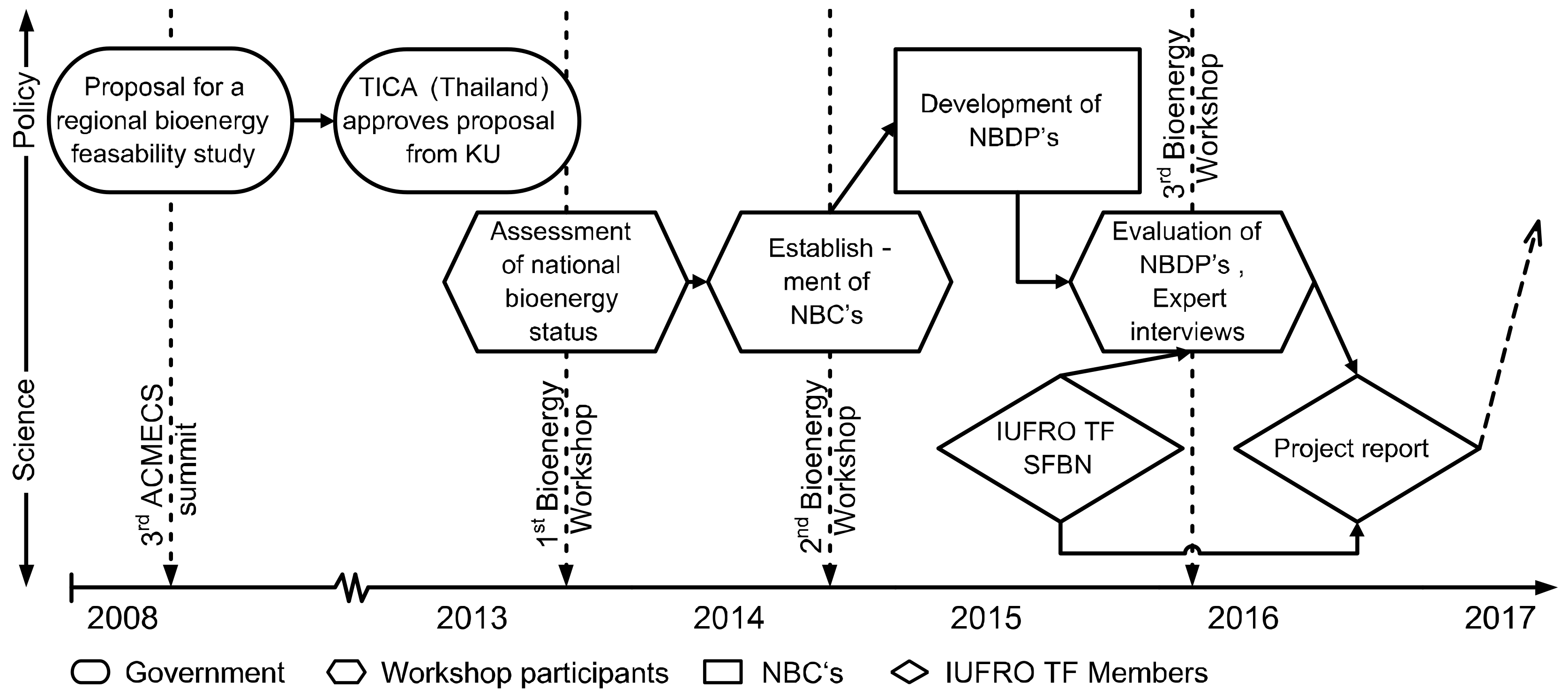
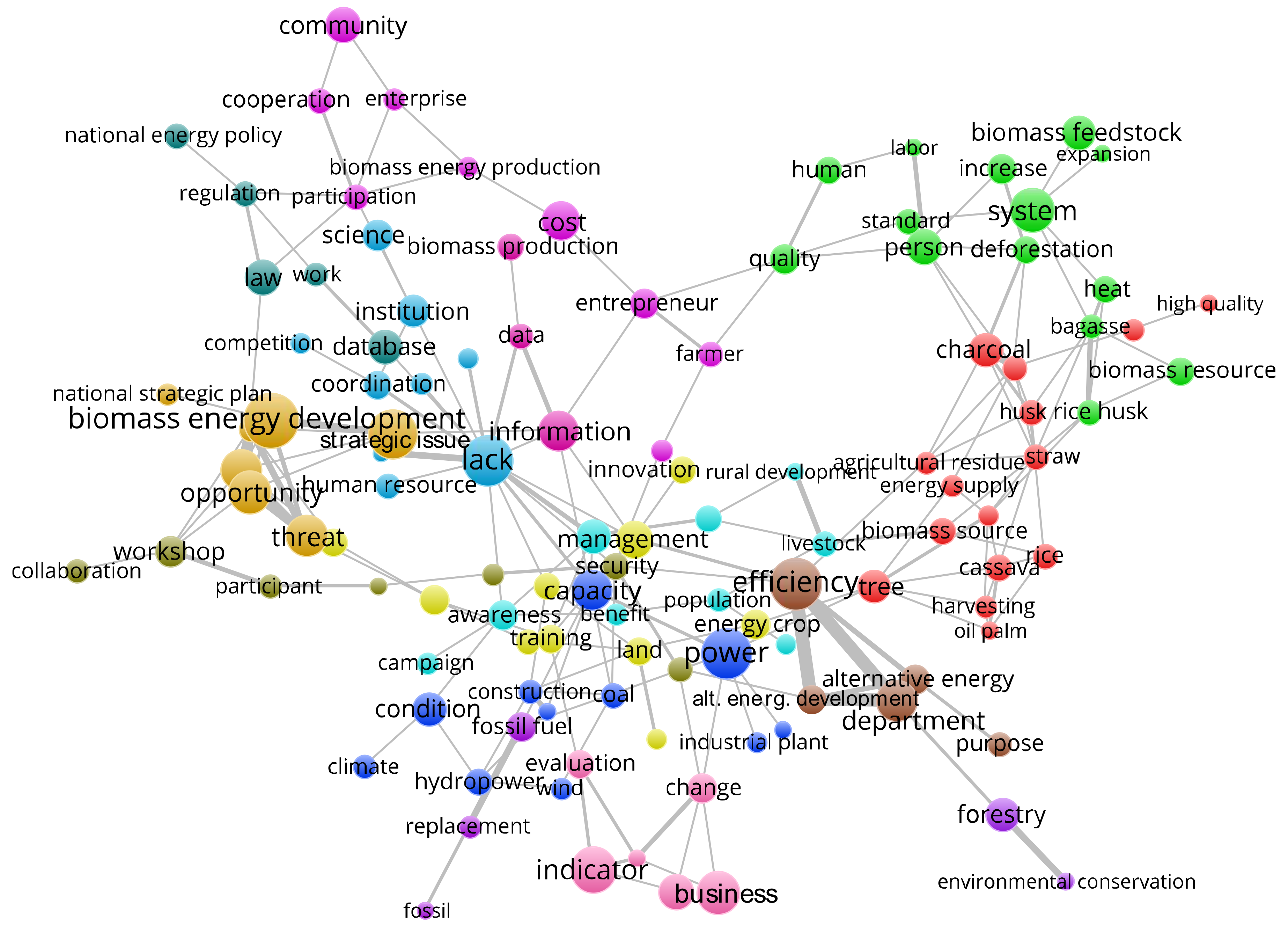
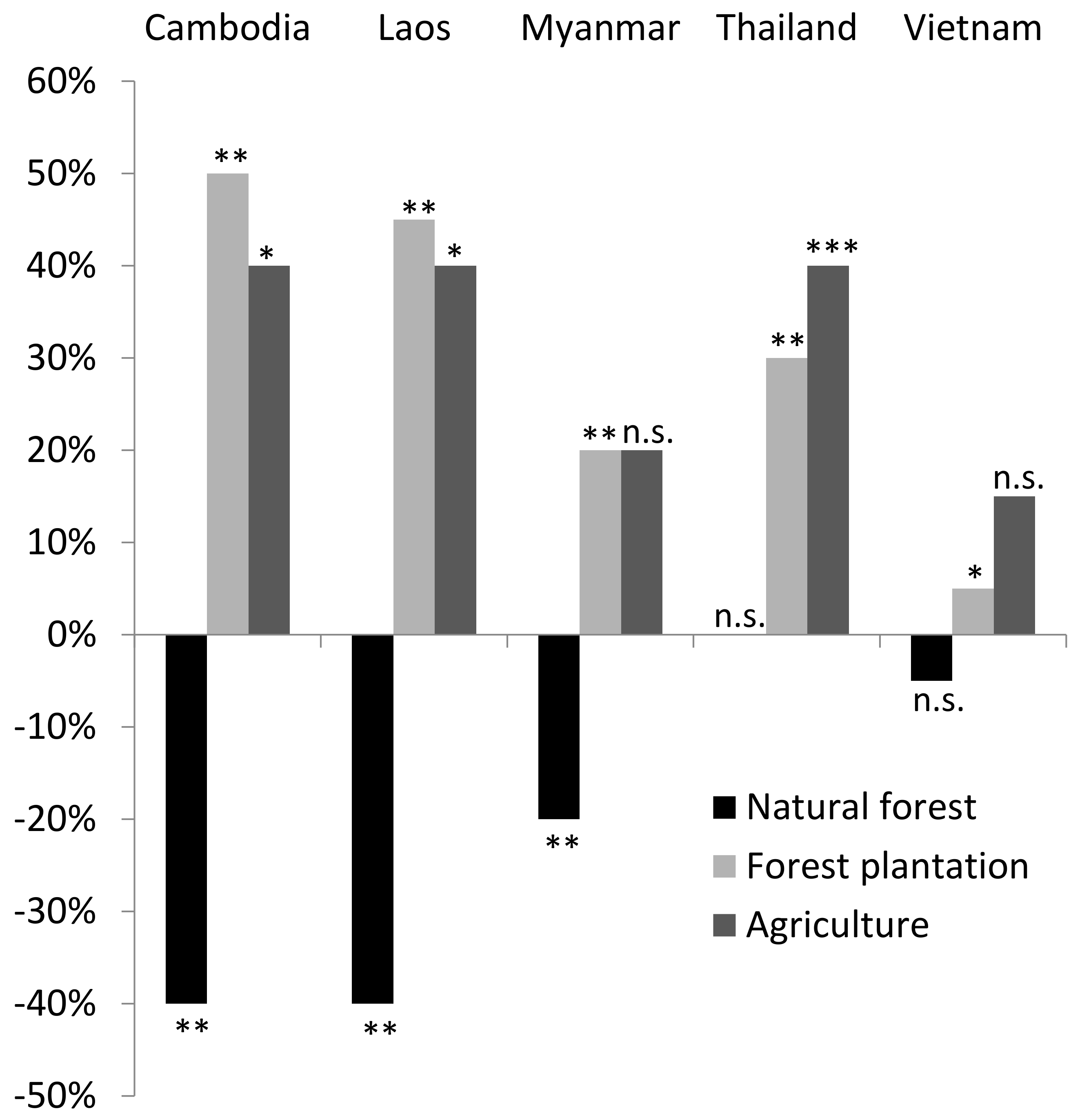
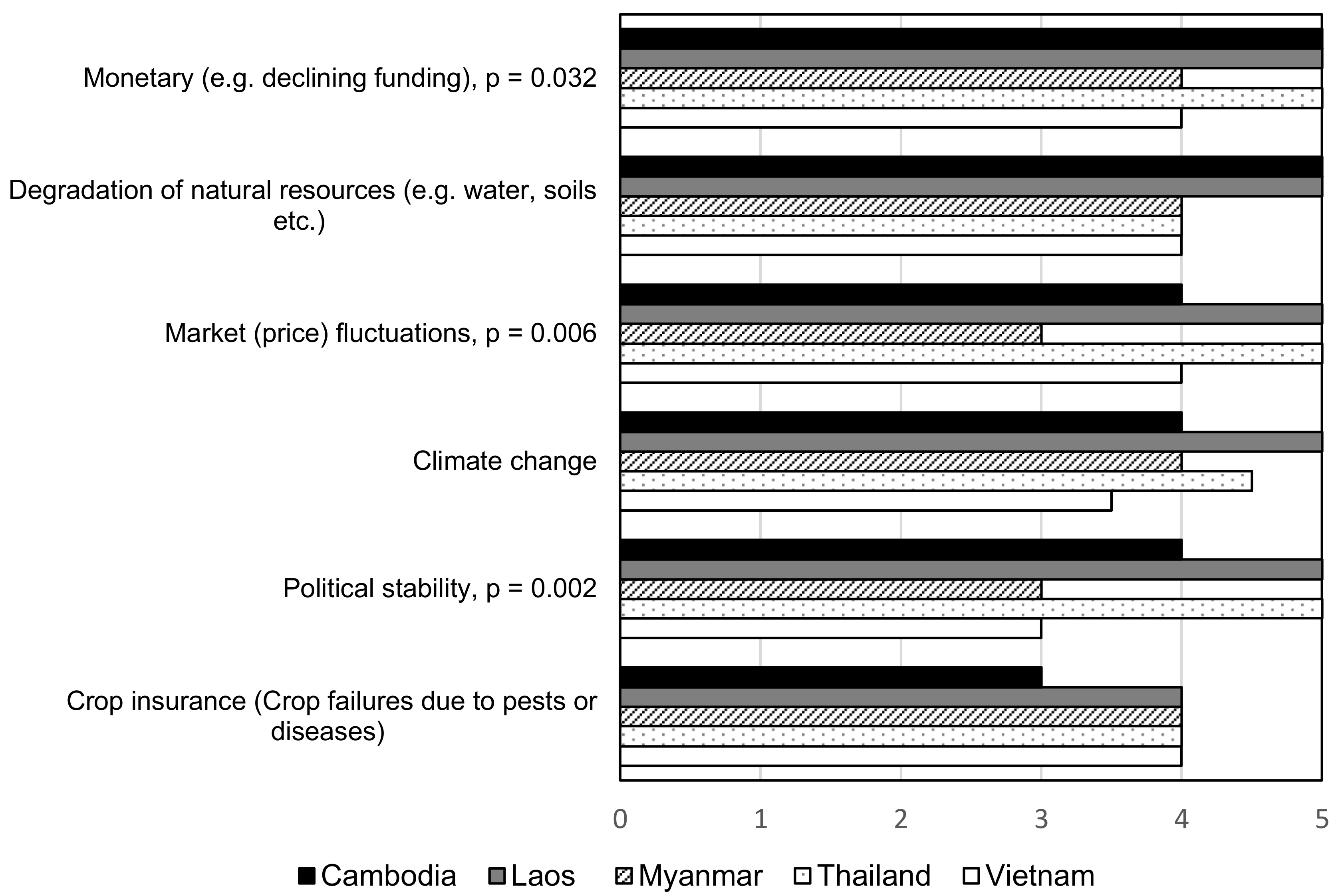
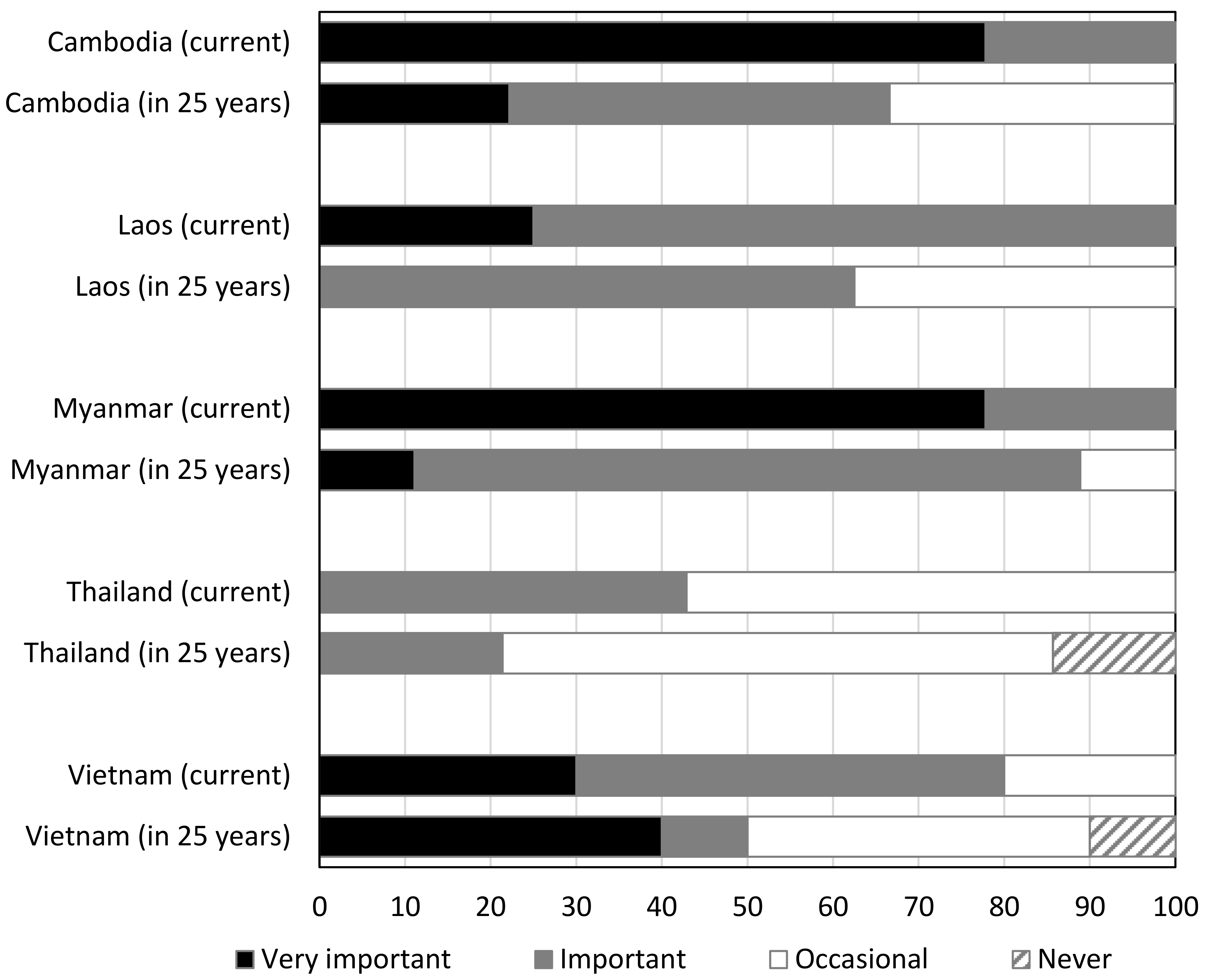
| HDI 1 | Land Area | Bioenergy 4 | Bioenergy Commodities Production 5 | ||||||||
|---|---|---|---|---|---|---|---|---|---|---|---|
| Total 2 | Forest 3 | Agriculture 2 | |||||||||
| 107 m−2 | 107 m−2 | % | 107 m−2 | % | % of Total Renewable Energy Production | Fuelwood [106 m−3] | Charcoal [103 t] | Woodchips [103 m−3] | Pellets [103 t] | ||
| Cambodia | 0.555 | 17,652 | 9457 | 54 | 5455 | 31 | 99.89 | 7.78 | 37.06 | no data | no data |
| Laos | 0.575 | 23,080 | 18,761 | 81 | 2369 | 10 | no data | 5.89 | 23.34 | no data | no data |
| Myanmar | 0.536 | 65,308 | 29,041 | 44 | 12,645 | 19 | 96.70 | 38.29 | 174.79 | no data | no data |
| Thailand | 0.726 | 51,089 | 16,399 | 32 | 22,110 | 43 | 97.09 | 18.81 | 1,448.76 | 2080.00 | 40.00 |
| Vietnam | 0.666 | 31,007 | 14,773 | 48 | 10,874 | 35 | 90.70 | 20.00 | 414.00 | 3312.00 | 1060.00 |
| Item | Description of Contents |
|---|---|
| Introduction | Concise description of the purpose of the document, development of the ACMECS bioenergy network, and existing transnational frameworks. |
| Basic information | Country-specific information on the national energy supply and demand, including trade, energy portfolio, and potential sources of energy in total numbers and specifically for biomass. Included is a listing of governmental bodies (ministries, agencies) that are involved in energy issues. Two sub-sections on “National energy profile” and “National bioenergy profile” are included. |
| SWOT Analysis | This includes a classical SWOT analysis on further bioenergy development in each country. Topics covered are of social nature (e.g., policy development, implementation, acceptance, socioeconomic consequences, market development, trade), environmental (e.g., sustainability in biomass production, soil conservation, biodiversity, land use change), and technical issues (e.g., technology transfer and development). Key strategic issues (<10) are listed with a brief description, with the aim to address findings of the SWOT analysis. |
| Strategic plan for biomass energy development | The strategic plan briefly elaborates on actual proposed activities, including indicators, with the aim to enable efficient controlling mechanisms. A more abstract vision is described and subsequently specified in detail by defining a goal and the key success indicators (KSI). KSI’s are linked to actual activities and critical success factors, and key performance indicators are defined accordingly. |
| Links to national energy policies | Here, the nexus between the NBDP with existing (renewable or bio-) energy regulations and frameworks is described. Where appropriate, potential regulations that can be included/amended are listed. |
| Follow-up and evaluation process | This section identifies potential evaluation approaches and briefly elaborates on reporting and documentation requirements. |
| Strengths | Weaknesses |
|
|
| Opportunities | Threats |
|
|

| Cambodia | Laos | Myanmar | Thailand | Vietnam | |
|---|---|---|---|---|---|
| Governmental incentives taxation, subsidies | 1 | 1 | 1 | 1 | 1 |
| Support in planning of renewable energy systems | 1 | 1 | 1 | 1 | 1 |
| Political commitment to bioenergy | 1 | 1 | 1 | 1 | 1 |
| Access to capital/investments | 2 | 1 | 1 | 1 | 1 |
| Data on biomass market supply | 1 | 1 | 2 | 1 | 1 |
| Human capital | 1 | 1 | 2 | 1 | 1 |
| Government support for community involvement | 2 | 1 | 2 | 1 | 1 |
| Education and capacity building | 1 | 2 | 1 | 3 | 1 |
| Collaboration among ACMECS countries | 1 | 2 | 1 | 3 | 1 |
| Data on biomass production constraints | 2 | 3 | 2 | 1 | 1 |
| Supporting data on land use | 2 | 3 | 1 | 1 | 3 |
| Biomass inventory data | 2 | 3 | 2 | 2 | 1 |
| Biomass availability on spatial scales | 2 | 3 | 2 | 3 | 1 |
| Collaboration among national institutions | 2 | 3 | 2 | 3 | 1 |
| International collaboration | 2 | 3 | 2 | 3 | 1 |
| Public acceptance for a bioenergy network | 2 | 3 | 2 | 3 | 2 |
| Theoretical biomass potentials in spatial scales | 2 | 3 | 2 | 3 | 2 |
| Spatially explicit soil data | 2 | 3 | 2 | 3 | 3 |

| Cambodia | Laos | Myanmar | Thailand | Vietnam | |
|---|---|---|---|---|---|
| Private corporations | 1 | 1 | 1 | 1 | 1 |
| Development banks | 1 | 1 | 1 | 1 | 1 |
| Commercial banks | 1 | 1 | 1 | 1 | 2 |
| REDD+ | 1 | 1 | 2 | 2 | 1 |
| NGO's | 2 | 2 | 1 | 2 | 1 |
| International large-scale investors | 1 | 2 | 2 | 2 | 2 |
| Small-scale and microcredit models | 2 | 2 | 2 | 2 | 3 |
© 2018 by the authors. Licensee MDPI, Basel, Switzerland. This article is an open access article distributed under the terms and conditions of the Creative Commons Attribution (CC BY) license (http://creativecommons.org/licenses/by/4.0/).
Share and Cite
Bruckman, V.J.; Haruthaithanasan, M.; Miller, R.O.; Terada, T.; Brenner, A.-K.; Kraxner, F.; Flaspohler, D. Sustainable Forest Bioenergy Development Strategies in Indochina: Collaborative Effort to Establish Regional Policies. Forests 2018, 9, 223. https://doi.org/10.3390/f9040223
Bruckman VJ, Haruthaithanasan M, Miller RO, Terada T, Brenner A-K, Kraxner F, Flaspohler D. Sustainable Forest Bioenergy Development Strategies in Indochina: Collaborative Effort to Establish Regional Policies. Forests. 2018; 9(4):223. https://doi.org/10.3390/f9040223
Chicago/Turabian StyleBruckman, Viktor J., Maliwan Haruthaithanasan, Raymond O. Miller, Toru Terada, Anna-Katharina Brenner, Florian Kraxner, and David Flaspohler. 2018. "Sustainable Forest Bioenergy Development Strategies in Indochina: Collaborative Effort to Establish Regional Policies" Forests 9, no. 4: 223. https://doi.org/10.3390/f9040223
APA StyleBruckman, V. J., Haruthaithanasan, M., Miller, R. O., Terada, T., Brenner, A.-K., Kraxner, F., & Flaspohler, D. (2018). Sustainable Forest Bioenergy Development Strategies in Indochina: Collaborative Effort to Establish Regional Policies. Forests, 9(4), 223. https://doi.org/10.3390/f9040223






